Yan Gao
SelfAug: Mitigating Catastrophic Forgetting in Retrieval-Augmented Generation via Distribution Self-Alignment
Sep 04, 2025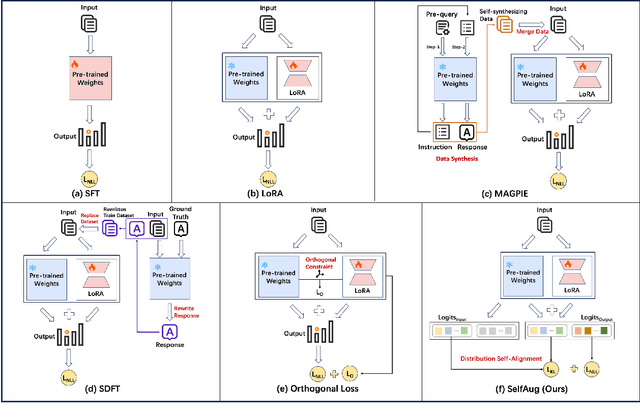
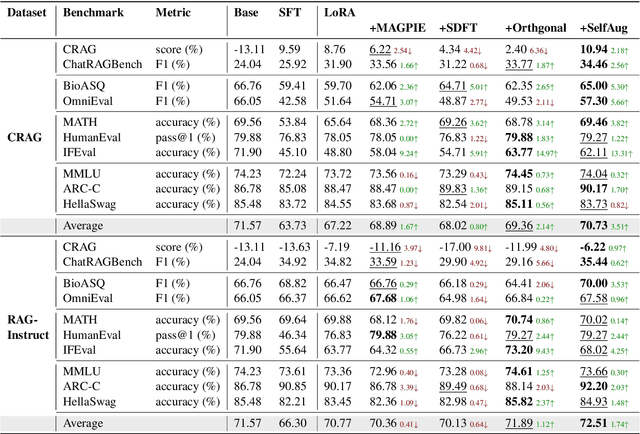
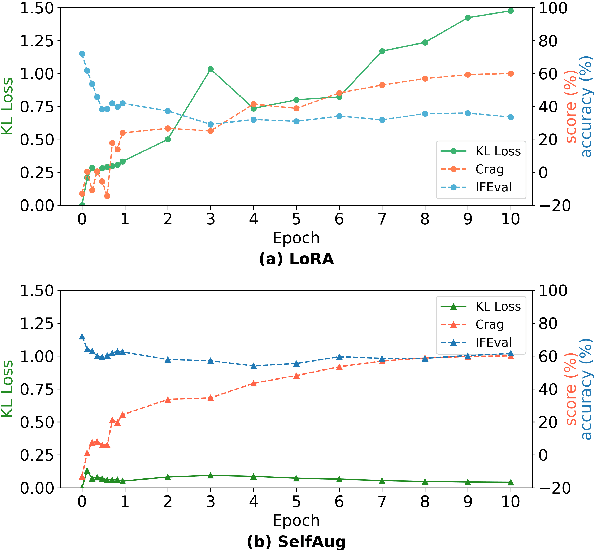
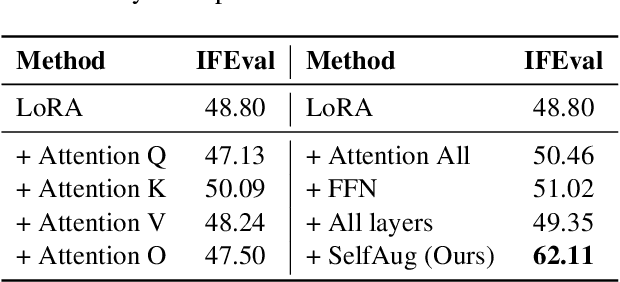
Abstract:Recent advancements in large language models (LLMs) have revolutionized natural language processing through their remarkable capabilities in understanding and executing diverse tasks. While supervised fine-tuning, particularly in Retrieval-Augmented Generation (RAG) scenarios, effectively enhances task-specific performance, it often leads to catastrophic forgetting, where models lose their previously acquired knowledge and general capabilities. Existing solutions either require access to general instruction data or face limitations in preserving the model's original distribution. To overcome these limitations, we propose SelfAug, a self-distribution alignment method that aligns input sequence logits to preserve the model's semantic distribution, thereby mitigating catastrophic forgetting and improving downstream performance. Extensive experiments demonstrate that SelfAug achieves a superior balance between downstream learning and general capability retention. Our comprehensive empirical analysis reveals a direct correlation between distribution shifts and the severity of catastrophic forgetting in RAG scenarios, highlighting how the absence of RAG capabilities in general instruction tuning leads to significant distribution shifts during fine-tuning. Our findings not only advance the understanding of catastrophic forgetting in RAG contexts but also provide a practical solution applicable across diverse fine-tuning scenarios. Our code is publicly available at https://github.com/USTC-StarTeam/SelfAug.
WideSearch: Benchmarking Agentic Broad Info-Seeking
Aug 11, 2025Abstract:From professional research to everyday planning, many tasks are bottlenecked by wide-scale information seeking, which is more repetitive than cognitively complex. With the rapid development of Large Language Models (LLMs), automated search agents powered by LLMs offer a promising solution to liberate humans from this tedious work. However, the capability of these agents to perform such "wide-context" collection reliably and completely remains largely unevaluated due to a lack of suitable benchmarks. To bridge this gap, we introduce WideSearch, a new benchmark engineered to evaluate agent reliability on these large-scale collection tasks. The benchmark features 200 manually curated questions (100 in English, 100 in Chinese) from over 15 diverse domains, grounded in real user queries. Each task requires agents to collect large-scale atomic information, which could be verified one by one objectively, and arrange it into a well-organized output. A rigorous five-stage quality control pipeline ensures the difficulty, completeness, and verifiability of the dataset. We benchmark over 10 state-of-the-art agentic search systems, including single-agent, multi-agent frameworks, and end-to-end commercial systems. Most systems achieve overall success rates near 0\%, with the best performer reaching just 5\%. However, given sufficient time, cross-validation by multiple human testers can achieve a near 100\% success rate. These results demonstrate that present search agents have critical deficiencies in large-scale information seeking, underscoring urgent areas for future research and development in agentic search. Our dataset, evaluation pipeline, and benchmark results have been publicly released at https://widesearch-seed.github.io/
Multi-modal Relational Item Representation Learning for Inferring Substitutable and Complementary Items
Jul 29, 2025Abstract:We introduce a novel self-supervised multi-modal relational item representation learning framework designed to infer substitutable and complementary items. Existing approaches primarily focus on modeling item-item associations deduced from user behaviors using graph neural networks (GNNs) or leveraging item content information. However, these methods often overlook critical challenges, such as noisy user behavior data and data sparsity due to the long-tailed distribution of these behaviors. In this paper, we propose MMSC, a self-supervised multi-modal relational item representation learning framework to address these challenges. Specifically, MMSC consists of three main components: (1) a multi-modal item representation learning module that leverages a multi-modal foundational model and learns from item metadata, (2) a self-supervised behavior-based representation learning module that denoises and learns from user behavior data, and (3) a hierarchical representation aggregation mechanism that integrates item representations at both the semantic and task levels. Additionally, we leverage LLMs to generate augmented training data, further enhancing the denoising process during training. We conduct extensive experiments on five real-world datasets, showing that MMSC outperforms existing baselines by 26.1% for substitutable recommendation and 39.2% for complementary recommendation. In addition, we empirically show that MMSC is effective in modeling cold-start items.
Plan Your Travel and Travel with Your Plan: Wide-Horizon Planning and Evaluation via LLM
Jun 14, 2025Abstract:Travel planning is a complex task requiring the integration of diverse real-world information and user preferences. While LLMs show promise, existing methods with long-horizon thinking struggle with handling multifaceted constraints and preferences in the context, leading to suboptimal itineraries. We formulate this as an $L^3$ planning problem, emphasizing long context, long instruction, and long output. To tackle this, we introduce Multiple Aspects of Planning (MAoP), enabling LLMs to conduct wide-horizon thinking to solve complex planning problems. Instead of direct planning, MAoP leverages the strategist to conduct pre-planning from various aspects and provide the planning blueprint for planning models, enabling strong inference-time scalability for better performance. In addition, current benchmarks overlook travel's dynamic nature, where past events impact subsequent journeys, failing to reflect real-world feasibility. To address this, we propose Travel-Sim, an agent-based benchmark assessing plans via real-world travel simulation. This work advances LLM capabilities in complex planning and offers novel insights for evaluating sophisticated scenarios through agent-based simulation.
PaRT: Enhancing Proactive Social Chatbots with Personalized Real-Time Retrieval
Apr 29, 2025Abstract:Social chatbots have become essential intelligent companions in daily scenarios ranging from emotional support to personal interaction. However, conventional chatbots with passive response mechanisms usually rely on users to initiate or sustain dialogues by bringing up new topics, resulting in diminished engagement and shortened dialogue duration. In this paper, we present PaRT, a novel framework enabling context-aware proactive dialogues for social chatbots through personalized real-time retrieval and generation. Specifically, PaRT first integrates user profiles and dialogue context into a large language model (LLM), which is initially prompted to refine user queries and recognize their underlying intents for the upcoming conversation. Guided by refined intents, the LLM generates personalized dialogue topics, which then serve as targeted queries to retrieve relevant passages from RedNote. Finally, we prompt LLMs with summarized passages to generate knowledge-grounded and engagement-optimized responses. Our approach has been running stably in a real-world production environment for more than 30 days, achieving a 21.77\% improvement in the average duration of dialogues.
Scaling Auditory Cognition via Test-Time Compute in Audio Language Models
Mar 30, 2025Abstract:Large language models (LLMs) have shown exceptional versatility in natural language processing, prompting recent efforts to extend their multimodal capabilities to speech processing through the development of audio large language models (Audio LLMs). While Audio LLMs excel in tasks such as speech recognition and synthesis, it remains unclear how they perform when faced with the auditory cognitive challenges posed by real-world environments, such as audio comprehension and listening recall, particularly in the presence of background noise or overlapping speech. Unlike text-based LLMs, which have access to vast amounts of text data for pre-training, retraining Audio LLMs with diverse auditory cognitive scenes is difficult due to the limited datasets that simulate real-world auditory cognitive scenarios and the challenge of acquiring auditory cognitive labels for training. While test-time compute (TTC) methods have been shown to enhance the capabilities of text-based LLMs during inference, a key challenge lies in designing these TTC methods to improve the auditory capabilities of Audio LLMs. This study aims to address these two research gaps by: i) exploring the auditory cognitive capabilities of Audio LLMs, and ii) enhancing their capabilities using TTC approaches. We have investigated five different Audio LLMs for auditory cognition using a \textit{self-collected} database and have proposed five TTC approaches to enhance auditory cognitive capabilities during inference. Our findings reveal that Audio LLMs performance decreases in more challenging auditory cognitive tasks. The proposed TTC approaches significantly enhance cognitive auditory capabilities, advancing the development of more adaptable and resilient Audio LLMs for practical applications such as assistive listening devices, voice-based AI assistants, and communication technologies.
FedSCA: Federated Tuning with Similarity-guided Collaborative Aggregation for Heterogeneous Medical Image Segmentation
Mar 19, 2025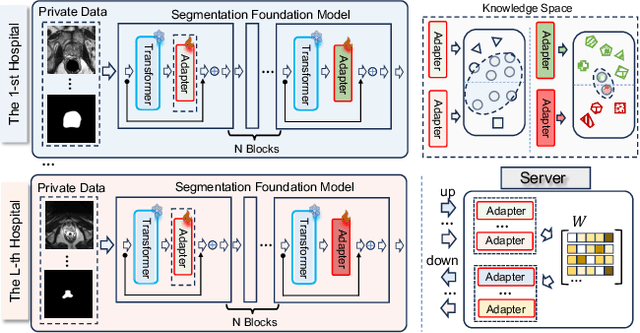

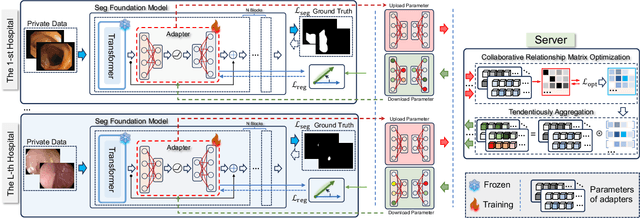

Abstract:Transformer-based foundation models (FMs) have recently demonstrated remarkable performance in medical image segmentation. However, scaling these models is challenging due to the limited size of medical image datasets within isolated hospitals, where data centralization is restricted due to privacy concerns. These constraints, combined with the data-intensive nature of FMs, hinder their broader application. Integrating federated learning (FL) with foundation models (FLFM) fine-tuning offers a potential solution to these challenges by enabling collaborative model training without data sharing, thus allowing FMs to take advantage of a diverse pool of sensitive medical image data across hospitals/clients. However, non-independent and identically distributed (non-IID) data among clients, paired with computational and communication constraints in federated environments, presents an additional challenge that limits further performance improvements and remains inadequately addressed in existing studies. In this work, we propose a novel FLFM fine-tuning framework, \underline{\textbf{Fed}}erated tuning with \underline{\textbf{S}}imilarity-guided \underline{\textbf{C}}ollaborative \underline{\textbf{A}}ggregation (FedSCA), encompassing all phases of the FL process. This includes (1) specially designed parameter-efficient fine-tuning (PEFT) for local client training to enhance computational efficiency; (2) partial low-level adapter transmission for communication efficiency; and (3) similarity-guided collaborative aggregation (SGCA) on the server side to address non-IID issues. Extensive experiments on three FL benchmarks for medical image segmentation demonstrate the effectiveness of our proposed FedSCA, establishing new SOTA performance.
PCL: Prompt-based Continual Learning for User Modeling in Recommender Systems
Feb 26, 2025



Abstract:User modeling in large e-commerce platforms aims to optimize user experiences by incorporating various customer activities. Traditional models targeting a single task often focus on specific business metrics, neglecting the comprehensive user behavior, and thus limiting their effectiveness. To develop more generalized user representations, some existing work adopts Multi-task Learning (MTL)approaches. But they all face the challenges of optimization imbalance and inefficiency in adapting to new tasks. Continual Learning (CL), which allows models to learn new tasks incrementally and independently, has emerged as a solution to MTL's limitations. However, CL faces the challenge of catastrophic forgetting, where previously learned knowledge is lost when the model is learning the new task. Inspired by the success of prompt tuning in Pretrained Language Models (PLMs), we propose PCL, a Prompt-based Continual Learning framework for user modeling, which utilizes position-wise prompts as external memory for each task, preserving knowledge and mitigating catastrophic forgetting. Additionally, we design contextual prompts to capture and leverage inter-task relationships during prompt tuning. We conduct extensive experiments on real-world datasets to demonstrate PCL's effectiveness.
A Dual-Perspective Metaphor Detection Framework Using Large Language Models
Dec 23, 2024Abstract:Metaphor detection, a critical task in natural language processing, involves identifying whether a particular word in a sentence is used metaphorically. Traditional approaches often rely on supervised learning models that implicitly encode semantic relationships based on metaphor theories. However, these methods often suffer from a lack of transparency in their decision-making processes, which undermines the reliability of their predictions. Recent research indicates that LLMs (large language models) exhibit significant potential in metaphor detection. Nevertheless, their reasoning capabilities are constrained by predefined knowledge graphs. To overcome these limitations, we propose DMD, a novel dual-perspective framework that harnesses both implicit and explicit applications of metaphor theories to guide LLMs in metaphor detection and adopts a self-judgment mechanism to validate the responses from the aforementioned forms of guidance. In comparison to previous methods, our framework offers more transparent reasoning processes and delivers more reliable predictions. Experimental results prove the effectiveness of DMD, demonstrating state-of-the-art performance across widely-used datasets.
ZigZagkv: Dynamic KV Cache Compression for Long-context Modeling based on Layer Uncertainty
Dec 12, 2024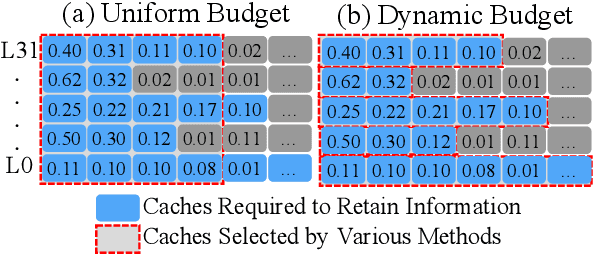



Abstract:Large Language models (LLMs) have become a research hotspot. To accelerate the inference of LLMs, storing computed caches in memory has become the standard technique. However, as the inference length increases, growing KV caches might lead to out-of-memory issues. Many existing methods address this issue through KV cache compression, primarily by preserving key tokens throughout all layers to reduce information loss. Most of them allocate a uniform budget size for each layer to retain. However, we observe that the minimum budget sizes needed to retain essential information vary across layers and models based on the perspectives of attention and hidden state output. Building on this observation, this paper proposes a simple yet effective KV cache compression method that leverages layer uncertainty to allocate budget size for each layer. Experimental results show that the proposed method can reduce memory usage of the KV caches to only $\sim$20\% when compared to Full KV inference while achieving nearly lossless performance.
 Add to Chrome
Add to Chrome Add to Firefox
Add to Firefox Add to Edge
Add to Edge